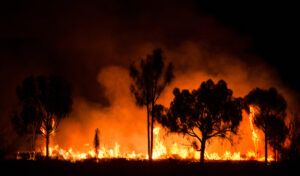Award-winning prosthetics in TV and film are made using hazardous chemicals. Neill Gorton at Millennium FX tells us how he keeps his staff safe from the creatures they’re building…
How do you make a monster? You’ve probably seen one of those programmes on TV, or included as a DVD extra, where they show how it’s done, interviewing the experts in prosthetics and special effects. There’s latex and animatronics, and a lot of skilled, painstaking work. Sometimes we might see people working in masks and other protective gear as they conjure these things into life. Yet it’s rare for behind-the-scenes features to mention a vital element of such work — the quality of the air.
‘Given the range of what we do, we work with a massive variety of materials, many of which can be hazardous to health,’ says Neill Gorton, co-founder and CEO of Millennium FX, which has won BAFTA and Royal Television Society awards for its extraordinary creations. ‘We do everything from the bodies you see in realistic dramas such as Silent Witness to the creatures in Doctor Who,’ explains Neill. His team has transformed Kenneth Branagh into Boris Johnson, aged up Pierce Brosnan for 2023’s The Last Rifleman and made horns, cyborg prostheses and a tail for singer Lady Gaga.
What exactly are the hazards of this kind of creative work? ‘In moulding and casting, we use a lot of fibreglass and polyurethanes that are all toxic at some level,’ says Neill. ‘We laminate with epoxy resins. Even working with clay and plaster produces a lot of dust. You think of clay as quite benign but it has a lot of silica in it so there’s a risk of silicosis. The dust from MDF woodwork can be carcinogenic. Anything in the atmosphere can be a real problem.’
Acknowledging these hazards, let alone addressing them, is relatively new in the industry. When Neill started out as an assistant in 1987, there was little understanding of the health risks. ‘I can remember people smoking at work while they spray-painted stuff with an aerosol, breathing in cigarette smoke and whatever came out of that can. The company I worked for had what they considered a mould-making room, which had one small fan in the window. A bunch of people worked there constructing things out of fibreglass, none of them wearing masks. You had workshops full of people cutting, grinding and sanding, throwing all this dust and muck into the air — and all breathing it in. There was no air flow or extraction. And they’d mix up various chemicals without even wearing gloves. Exposure to polyurethanes, particularly isocyanates, can be horrendous.’
Things are very different now — so what changed? ‘I think it slowly crept in as the industry grew. Special effects has always been a cottage industry of small workshops, converted garages and units. Our company was like that when we started, with two small rooms in a workshop barely 500 square feet in size, a few benches and a handful of people. A big extraction system is a sizeable expense so I can see the temptation to go, “We’ll just open a window…”’
Today, Millennium employs 14 full-time staff across two sites, one in Cornwall and the other in Aylesbury, the latter comprising a building with 10,000 square feet of space. It can take on as many as 60 freelancers at a time for particular assignments, all of them working with potentially hazardous materials. ‘We’ve spent a lot of money on high-quality extraction systems in both sites,’ says Neill. But he thinks this reflects a wider trend in special effects as the industry has expanded.
‘Partly that’s because with bigger-scale operations you have healthy and safety people to oversee that kind of thing,’ he says. ‘But also people are smarter about the risks to health. When I started out, we just weren’t really aware of these problems. Now everyone takes it seriously.’
What does Millennium do to keep people working on site safe? ‘We have dedicated working spaces with big extraction systems.’ Indeed, as we speak to Neill over Zoom — he’s sat in front of shelves of various disembodies heads — there’s a constant, reassuring thrum from those very systems. ‘We also have big metal-walled spray-painting booths, the biggest one about 2m by 4m. The walls are fitted with filters and spark-proof fans so we can suck out solvent-based sprays. The same system will draw out dust and fumes, for example when we’re working with fibreglass. As well as spray booths we have individual extraction units, including ones we can move around and put next to whatever we’re working on. Then the staff all have personal PPE. Everyone puts on a respirator whenever they’re working in proximity to these kinds of chemicals and fumes.’
The team were regularly wearing PPE at work before the Covid pandemic struck and were able to carry on working during lockdown. ‘Yes, we were lucky there,’ says Neill. ‘Other bits of film and TV production had to shut down. The one job that kept going was [satirical puppet show] Spitting Image, because you didn’t see the puppeteers during the performance so they could all be masked up while recording. The individual sculptors on that nearly all worked from home anyway, so when they’d sculpted a new head someone would collect it from them and drop it off outside our building. We had a large, ventilated space and the right PPE so we could keep working.’
That, surely, shows the benefit of being an early adopter of this kind of process. What advice can Neill give to anyone else considering air quality in their workplace? ‘It’s something I get asked about a lot,’ he says. ‘I run an MA in prosthetic effects at Falmouth University, I’ve been a visiting professor at Bolton University for the past 10 years and I do consultations for other universities as they’re thinking about setting up workshops or similar spaces. I’ll look at their facilities and advise on what’s practical.’
‘The main problem with our kind of work is that it involves a lot of different processes,’ he continues. ‘In a normal factory environment, you have a production line of single processes that get repeated: there’s the spot where you cut things and the spot where you join them, then the spot where you spray them. You can tailor your extraction system to each of those tasks. But we might use a spot to spray stuff and then the next week the same spot is used for cutting and grinding fibreglass. Or it might be used for working with expanding polyurethane foam that produces loads of gas. We might not know what we’re going to be working with on that particular spot, which means the space has to be adaptable and cover all these kinds of issue. Colleges and universities are exactly the same: they can’t afford to dedicate spaces to particular, individual processes as they might sit unused for days or weeks at a time.’
Another issue arises where existing space is converted for this kind of use. ‘With universities, the buildings I visit are often not brand new. The people I see have been given a certain, pre-existing space and want to use it for certain processes. I then advise them on whether that’s really practical. For example, you need a big extraction system to suck up the air from the space in which you’re working and pump it outside through an exhaust. But the further that air has to be pumped, the less effective the system. If the workshop is in the middle of an existing building, you can’t pump out the air very well.
‘You also have to factor in how fresh air will enter the space to make up for what you’ve extracted. In an industrial unit, you might have roller-shutter doors leading straight outside and fresh air can enter through those. But a room deep inside a building might be more blocked in. You think, “Oh, we’ll draw air from the corridors of the building,” but then you find it’s lined with fire doors that all have to be kept shut and there isn’t that airflow. We go through issues like that. They might be able to move somewhere else. Or I can advise them on different kinds of work to do, or in using different, safer materials that mean they can still use the space as intended.’
‘There are lots of things you can do,’ Neill concludes. ‘The main thing is to be aware it’s an issue in the first place.’
















Leave a Reply